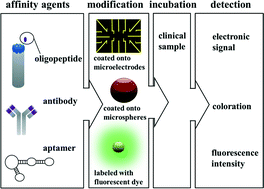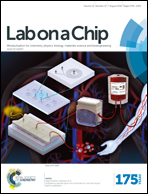Microfluidics in the selection of affinity reagents for the detection of cancer: paving a way towards future diagnostics
Abstract
Microfluidic technologies have miniaturized a variety of biomedical applications, and these chip-based systems have several significant advantages over their large-scale counterparts. Recently, this technology has been used for automating labor-intensive and time-consuming screening processes, whereby affinity reagents, including aptamers, peptides, antibodies, polysaccharides, glycoproteins, and a variety of small molecules, are used to probe for molecular biomarkers. When compared to conventional methods, the microfluidic approaches are faster, more compact, require considerably smaller quantities of samples and reagents, and can be automated. Furthermore, they allow for more precise control of reaction conditions (e.g., pH, temperature, and shearing forces) such that more efficient screening can be performed. A variety of affinity reagents for targeting cancer cells or cancer biomarkers are now available and will likely replace conventional antibodies. In this review article, the selection of affinity reagents for cancer cells or cancer biomarkers on microfluidic platforms is reviewed with the aim of highlighting the utility of such approaches in cancer diagnostics.

- This article is part of the themed collection: Lab on a Chip Recent Review Articles

 Please wait while we load your content...
Please wait while we load your content...